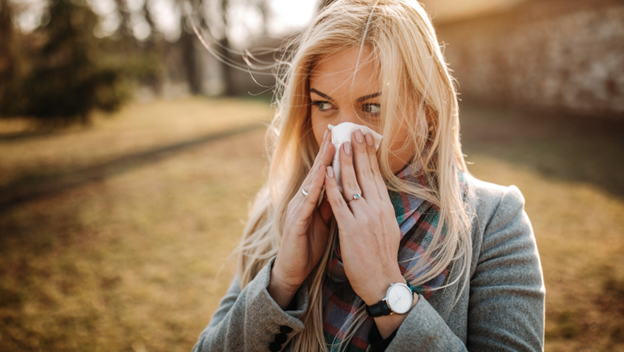According to ACAAI, over 50 million Americans suffer from allergies, the sixth cause of chronic illness in the US. In Texas, fall starts in September, leading to a dry winter in December, making it challenging for allergy sufferers. With its sprawling landscapes and varied climates, Texas is renowned for many things. However, fall allergies aren’t one of its more celebrated features. With autumn’s onset, Texans feel the familiar tug of seasonal allergies. It’s crucial to distinguish between mild reactions and those that necessitate an emergency room (ER) visit.
Fall Allergens in Texas
Navigating Texas’s fall allergies means understanding what’s making us sneeze and sniffle as we move from the warm summer into the crisper, cooler months of fall and winter. Let’s break down the usual suspects:
- Ragweed Pollen: A significant player in fall allergies, a single ragweed plant can unleash one billion pollen grains, saturating our air with sneeze-inducing particles.
- Molds: As fallen leaves get wet and decay, they create a perfect home for molds. Typical fall activities like raking can stir up these spores, giving allergy sufferers a hard time.
- Mountain Cedar: This one is noteworthy in Central Texas. From late fall into winter, mountain cedar pollen steps onto the stage, affecting many with its potent pollen.
- Other Pollens: While we often associate grass pollens like Bermuda, Kentucky bluegrass, and ryegrass with spring, they’re also on the roster for fall allergies.
- (Shikha Mane, 2019)
Symptoms to Watch Out For
Fall allergy symptoms can make you feel a bit off, or they can strike you. Common symptoms might include:
- Sneezing
- A nose that either won’t stop running or feels blocked up
- Eyes that itch and run
- Coughing
- Dark circles popping up under your eyes
- Feeling tired all the time
It might seem like you’ve caught a cold, but if these symptoms stick around for over a week or ten days (which is how long a cold usually lasts), it’s likely allergies.
When Allergies Get Real Serious: Anaphylaxis
Anaphylaxis is a severe and potentially fatal allergic reaction that occurs rapidly after exposure to an allergen. This heightened immune response can affect various systems in the body and lead to a range of symptoms, from difficulty breathing and swelling of the throat to a drop in blood pressure and loss of consciousness. (Health One Medicine, 2023)
When to Go to the ER
Allergies, while often manageable with over-the-counter remedies or prescription medications, can sometimes present emergencies that require immediate medical attention. Here’s when it might be time to go to the Emergency Room (ER):
- Breathing Difficulties: If you or someone else is struggling to breathe or experiencing shortness of breath, it is imperative to seek emergency care.
- Swelling: Severe swelling, particularly of the face and throat, that impedes breathing or swallowing requires immediate attention.
- Anaphylaxis: This is a severe, potentially life-threatening allergic reaction. Symptoms may include difficulty breathing, tightness in the throat, swelling of the lips or tongue, a rapid pulse, a drop in blood pressure, or loss of consciousness. Anaphylaxis is an absolute emergency.
- Persistently High Fever: While unfamiliar with allergies, if someone is experiencing a high fever along with other symptoms, it’s essential to rule out other illnesses or complications.
- Chest Pain: If allergic reactions lead to chest pain or tightness, especially if it radiates to the arm or jaw, immediate medical evaluation is critical to rule out other severe conditions.
- Uncontrolled Symptoms: If your allergy symptoms aren’t getting better with your usual medications, or if they’re getting worse, consider going to the ER, especially if they’re interfering with your ability to function normally or sleep.
(Centers for Disease Control and Prevention, 2022)
Always prioritize your safety and well-being. If in doubt, it’s better to consult healthcare professionals or visit the ER, especially when dealing with severe allergy symptoms or any concerning health issues. Remember: It’s crucial to consult with your healthcare provider about your symptoms and appropriate steps to take during a severe allergy flare-up.
Works Cited
Shikha Mane, M.D. “Fall Allergies.” North Texas Allergy & Asthma Center, 23 Oct. 2019,
www.northtexasallergy.com/fall-allergies/.
Health One Family Medicine. “Texas Seasonal Allergies: All You Need to Know.” Health One Family Medicine, 30 Aug. 2023,
irvingprimarycare.com/blog/texas-seasonal-allergies-all-you-need-to-know/.
Centers for Disease Control and Prevention. “Flu: What to Do If You Get Sick.” Centers for Disease Control and Prevention, 15 Dec. 2022, www.cdc.gov/flu/treatment/takingcare.html.




